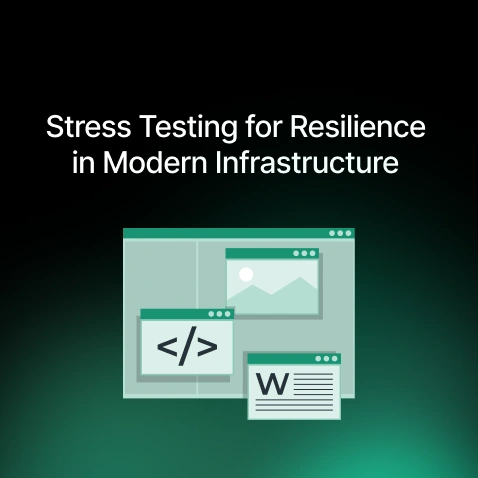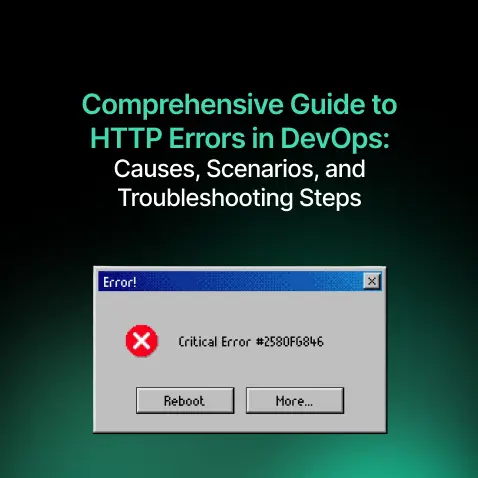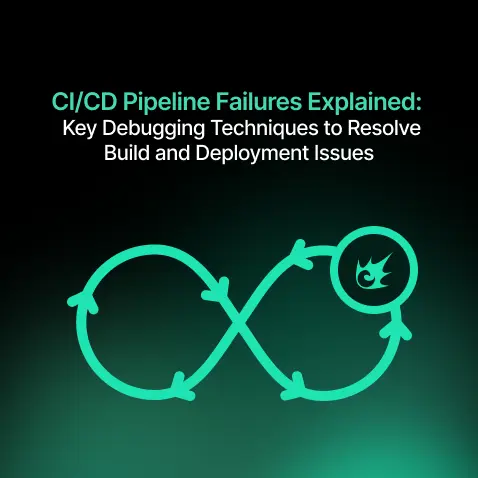Stress Testing for Resilience in Modern Infrastructure
- Ankush Madaan
- Blog
About

Industries
- Chaos Engineering, Modern Infrastructure, Resilience, SquareOps, Stress Testing
Share Via
Introduction
Infrastructure resilience, therefore, has to be critical in today’s digital-first world. Users’ expectations of seamless performance mean the system cannot afford downtime or a disruption, that might turn into losses in revenue and reputations. Therefore, no one can underestimate the role of stress testing for ensuring that the systems are resilient against unfortunate events and failures. Indeed, chaos engineering is an innovation concerning testing infrastructure resilience, these days. This article reveals chaos engineering, defining what deliberate failures are so that one understands how they are introduced into the test to understand the robustness and adaptability of systems, which is especially useful for companies in building a more resilient infrastructure.
What Is Chaos Engineering?
Chaos engineering is the practice of deliberately introducing failures or instabilities into a system to uncover weaknesses before they result in actual outages. Inspired by the concept of “chaos theory,” where small, seemingly random disruptions can have far-reaching effects, chaos engineering operates on a similar principle: minor disturbances can cause significant system impacts.
In chaos engineering, engineers use simulations to subject systems to real-world conditions, such as server failures, high traffic loads, or unexpected disconnections. The goal is not to cause system crashes but to understand how a system behaves under stress and, more importantly, how to improve its resilience.
The Importance of Resilience in Infrastructure
In the digital world where everything runs 24/7, infrastructure resilience is no longer an indulgence but a necessity. Systems are now designed with the intention of processing uninterrupted, unpredictable changes. Plus, users expect zero downtime. Whether it’s traffic surges, hardware malfunction, or indeed cyber attacks, businesses want their systems to adapt and recover quickly.
Resilience testing ensures the ability to:

Testing for these scenarios allows businesses to not only survive but also thrive during unexpected disruptions, maintaining their competitive edge.
Key Concepts in Chaos Engineering
- Hypothesis-Driven Experiments: Chaos engineering isn’t random; it’s structured. Engineers form hypotheses based on how they believe their system should respond to failures. By running experiments, they can either confirm the system’s resilience or expose weaknesses.
- Small-Scale Failure Testing: Chaos engineering begins small. Instead of bringing down an entire system, engineers will test failure in isolated, non-critical environments. Once successful, they gradually scale up the experiments.
- Steady-State Behavior: Understanding a system’s steady state—its normal, expected performance—is crucial. This provides a benchmark to measure changes in system behavior when introducing chaos, allowing engineers to identify deviations and troubleshoot performance issues.
- Fault Injection: This refers to deliberately inducing errors such as server crashes, network latency, or connection failures into a system. These are the stress points that reveal the system’s true behavior under pressure.
- Automated Monitoring: Continuous monitoring plays a pivotal role in chaos engineering. Tools like Prometheus, Grafana, and Datadog help track system behavior, providing insights into how services respond to failure, allowing for real-time diagnosis.
Best Practices for Stress Testing with Chaos Engineering
- Start Small, Build Confidence: Begin by introducing small, controlled failures in non-critical environments. These could include:
- Simulating server crashes.
- Injecting artificial latency in microservices.
- Temporarily disconnecting databases.
- As your team becomes more confident in handling small-scale failures, you can scale up to larger, more complex scenarios.
- Plan Hypotheses Carefully: The backbone of chaos engineering lies in forming clear hypotheses. For example, “If one node in our microservices architecture goes down, traffic should seamlessly redirect to another node without impacting users.” Test this hypothesis through experiments.
- Use Established Chaos Tools: Tools like Gremlin, LitmusChaos, Chaos Monkey, AWS FIS and Chaos Toolkit have made chaos engineering accessible. These tools provide interfaces to automate fault injection and chaos experiments, allowing businesses to test various failure scenarios effectively.
- Prioritize Core Systems: Start by testing the most critical parts of your infrastructure. If a service is fundamental to operations, like a payments gateway or customer database, stress test these systems first to ensure they can recover swiftly and autonomously.
- Iterate and Learn: Chaos engineering is an iterative process. After every experiment, teams should analyze the outcomes, document the findings, and adjust their systems accordingly. By continually running these tests, resilience can be built incrementally over time.
Common Scenarios for Chaos Engineering
- Network Failures: By simulating slow or dropped connections, engineers can test how their systems handle unreliable networking. This is especially important for distributed applications where data must move between multiple nodes or regions.
- Database Outages: Many services rely on constant access to a database. By simulating database downtime or intermittent disconnections, engineers can ensure that their application can remain functional even with database instability.
- Traffic Spikes: In an age of viral moments and unexpected high-traffic events, testing how systems handle sudden traffic surges is critical. Stress testing by increasing traffic levels can help teams understand the limits of their infrastructure and implement auto-scaling mechanisms.
- Hardware Failures: Simulating disk failures, CPU throttling, or RAM overload can expose weaknesses in hardware redundancy strategies. Testing the resilience of data replication and failover mechanisms ensures that the system remains operational despite hardware issues.
The Role of Automation in Chaos Engineering
In modern infrastructure, automation is the backbone of resilience testing. Automated tests and simulations allow organizations to run chaos experiments at scale without manual intervention. Automation tools like Terraform and Jenkins can be configured to set up chaos experiments, inject faults, and restore normalcy after the test concludes.
Automation ensures that chaos engineering becomes a continuous process rather than a one-off experiment. With the right configuration, teams can perform chaos experiments as part of their CI/CD pipelines, ensuring that every deployment is stress-tested for resilience.
Building a Culture of Resilience
Successful chaos engineering isn’t just about the tools or the experiments—it’s about building a culture of resilience. This means fostering a blame-free environment where teams feel comfortable exploring potential weaknesses and learning from failures. Chaos engineering encourages cross-team collaboration, where developers, operations, and security teams work together to strengthen infrastructure.
In addition, regular post-mortem reviews of chaos experiments help teams identify not only what went wrong but also how they can improve processes, architectures, and response protocols.
Conclusion: Preparing for the Unpredictable
Failure of infrastructure in this complex digital world becomes an unavoidable nuisance, but by way of chaos engineering and stress testing, systems may be prepared for in advance, designing them to be resilient under the test of challenges.
Adopting chaos-first brings weaknesses in earlier stages before they have a chance to blow out of proportion, ensuring that services are available, performant, and scalable across all conditions. Downtime is so unacceptable that it can no longer be an option; in fact, it is no longer negotiable – it must be ensured by stress testing for resilience.
Frequently asked questions
Chaos engineering is the practice of experimenting on a system to identify potential weaknesses by introducing controlled disruptions, simulating real-world failures to improve system resilience.
Engineers create controlled failures, such as shutting down services or introducing latency, to observe how the system responds and fix issues before they occur in production.
Stress testing involves simulating high loads and extreme conditions on infrastructure to assess its ability to perform under pressure, ensuring resilience and preventing failures during peak demand.
Automation in chaos engineering allows for continuous, repeatable, and controlled experiments that simulate failures in complex systems. It reduces manual effort, increases testing frequency, and ensures consistency across tests.
Tools like Gremlin, Chaos Monkey, Chaos Toolkit, Locust, and Apache JMeter are popular for simulating chaos experiments, automating stress tests, and monitoring system responses.
Yes, automation is a key best practice. Tools like Gremlin and Chaos Toolkit allow you to automate chaos experiments, integrate them into CI/CD pipelines, and ensure that stress tests are repeatable and consistent.
Common scenarios include network failures, service crashes, resource exhaustion, latency injection, disk failures, database unavailability, and external API disruptions, among others. Each scenario tests how the system responds to different types of failure.
Long-term benefits include faster identification and resolution of system weaknesses, improved system uptime, better disaster recovery processes, and an overall culture of continuous improvement in system resilience.
Challenges include setting up safe guardrails to prevent experiments from affecting critical production systems, ensuring reliable monitoring, and maintaining test consistency across diverse infrastructure configurations.
With increasing reliance on digital services, resilience is critical to maintain uptime, ensure business continuity, and provide a consistent user experience, even during unexpected failures or stress events. It helps prevent data loss, downtime, and service degradation.
Related Posts

Comprehensive Guide to HTTP Errors in DevOps: Causes, Scenarios, and Troubleshooting Steps
- Blog

Trivy: The Ultimate Open-Source Tool for Container Vulnerability Scanning and SBOM Generation
- Blog

Prometheus and Grafana Explained: Monitoring and Visualizing Kubernetes Metrics Like a Pro
- Blog

CI/CD Pipeline Failures Explained: Key Debugging Techniques to Resolve Build and Deployment Issues
- Blog

DevSecOps in Action: A Complete Guide to Secure CI/CD Workflows
- Blog

AWS WAF Explained: Protect Your APIs with Smart Rate Limiting
- Blog

